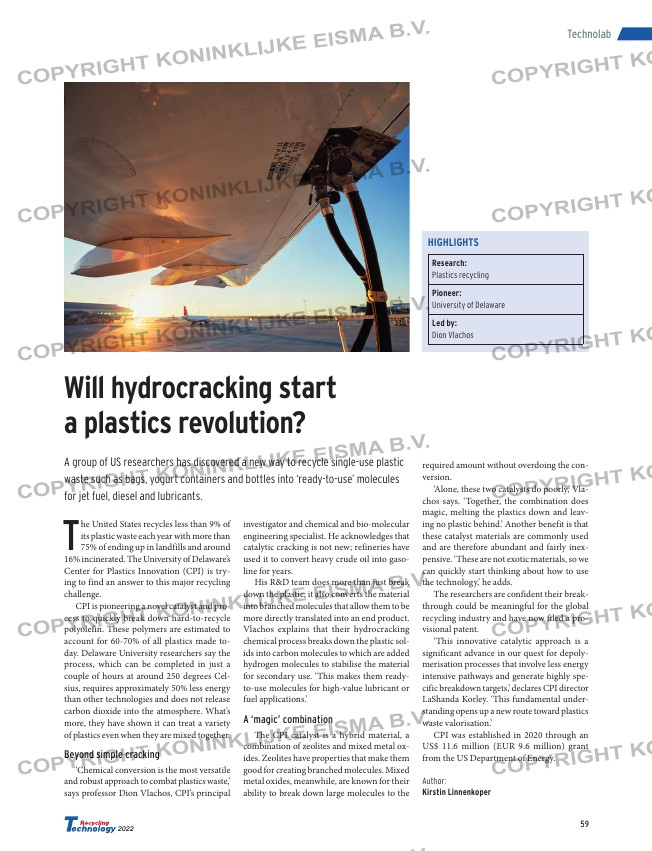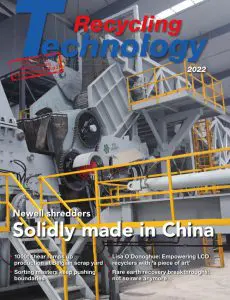Page 59 from: Recycling Technology issue | 2022

T
he United States recycles less than 9% of
its plastic waste each year with more than
75% of ending up in landfills and around
16% incinerated. The University of Delaware’s
Center for Plastics Innovation (CPI) is try-
ing to find an answer to this major recycling
challenge.
CPI is pioneering a novel catalyst and pro-
cess to quickly break down hard-to-recycle
polyolefin. These polymers are estimated to
account for 60-70% of all plastics made to-
day. Delaware University researchers say the
process, which can be completed in just a
couple of hours at around 250 degrees Cel-
sius, requires approximately 50% less energy
than other technologies and does not release
carbon dioxide into the atmosphere. What’s
more, they have shown it can treat a variety
of plastics even when they are mixed together.
Beyond simple cracking
‘Chemical conversion is the most versatile
and robust approach to combat plastics waste,’
says professor Dion Vlachos, CPI’s principal
investigator and chemical and bio-molecular
engineering specialist. He acknowledges that
catalytic cracking is not new; refineries have
used it to convert heavy crude oil into gaso-
line for years.
His R&D team does more than just break
down the plastic; it also converts the material
into branched molecules that allow them to be
more directly translated into an end product.
Vlachos explains that their hydrocracking
chemical process breaks down the plastic sol-
ids into carbon molecules to which are added
hydrogen molecules to stabilise the material
for secondary use. ‘This makes them ready-
to-use molecules for high-value lubricant or
fuel applications.’
A ‘magic’ combination
The CPI catalyst is a hybrid material, a
combination of zeolites and mixed metal ox-
ides. Zeolites have properties that make them
good for creating branched molecules. Mixed
metal oxides, meanwhile, are known for their
ability to break down large molecules to the
required amount without overdoing the con-
version.
‘Alone, these two catalysts do poorly,’ Vla-
chos says. ‘Together, the combination does
magic, melting the plastics down and leav-
ing no plastic behind.’ Another benefit is that
these catalyst materials are commonly used
and are therefore abundant and fairly inex-
pensive. ‘These are not exotic materials, so we
can quickly start thinking about how to use
the technology,’ he adds.
The researchers are confident their break-
through could be meaningful for the global
recycling industry and have now filed a pro-
visional patent.
‘This innovative catalytic approach is a
significant advance in our quest for depoly-
merisation processes that involve less energy
intensive pathways and generate highly spe-
cific breakdown targets,’ declares CPI director
LaShanda Korley. ‘This fundamental under-
standing opens up a new route toward plastics
waste valorisation.’
CPI was established in 2020 through an
US$ 11.6 million (EUR 9.6 million) grant
from the US Department of Energy.
Author:
Kirstin Linnenkoper
HigHLigHts
Research:
Plastics recycling
Pioneer:
University of Delaware
Led by:
Dion Vlachos
Will hydrocracking start
a plastics revolution?
A group of US researchers has discovered a new way to recycle single-use plastic
waste such as bags, yogurt containers and bottles into ‘ready-to-use’ molecules
for jet fuel, diesel and lubricants.
59
2022
Technolab
59_techno-lab.indd 59 31-08-21 16:07



